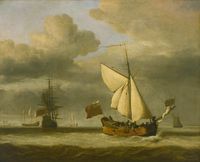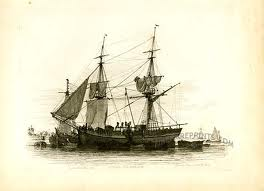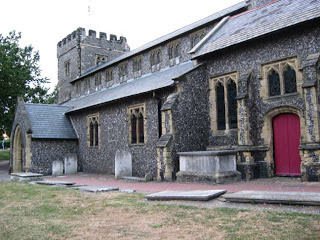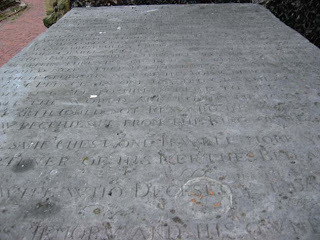October 12, 1651 - a ship for the king
Early on the morning of October 12, Colonel Phelipps leftLawrence Hyde's house at Hinton Daubney and rode to Heale House near Salisburywhere Charles was hidden. "After 4 or 5 days [at Mrs. Hyde's house]," Charlestold Samuel Pepys many years later, "Robin Phillipps came to the House, and acquaintedme that a Shipp was ready provided for me at Shoram, by Coll. Gunter."
His description is surprisingly matter-of-fact, consideringwhat he had been through over the five and a half weeks since he had fled Worcester. But maybe he was recalling that after so manyfailures he couldn't quite believe he was really about to make his escape. Or maybe his recollection of the actual newsis a little off, as according to Colonel Phelipps he informed Dr. Henchman ofthe plan, and "the same evening, Dr. Henchman went to Heale to give notice ofthe success and to prepare the King to bee ready at the meadow-gate openinginto the river, where Coll. Philipps would bee by three of the clock in themorning with a leade-horse for the King."
 The coal-brig Surprise by Willem van Velder the Elder
The coal-brig Surprise by Willem van Velder the Elder
after Charles converted it to a yacht which he kept moored near Whitehall
According to Richard Ollard's The Escape of Charles II After the Battle of Worcester, "NicholasTettersell, master and owner of the coal-brig Surprise (thirty-four tons)," who was to carry the king to safety, "wasa native of Brighton and an experienced Channel seaman. He belongs to a type, now all but extinctsince the decay in the last fifty years [Ollard was writing in 1966] of theinshore fishery and the coastal trade, which altered perhaps less than anyother in our society between the Norman conquest, and the death of QueenVictoria … not only because of the obvious fact of geography but by the natureof the life they led, isolated from the world behind the harbor and untouchedby social and technological change. ColonelGunter had recognized this when he told Wilmot that though he had lived all hislife next door to these people he knew absolutely nothing about them."
A small coal-brig usually used for fairly short trips out ofa tiny place like Shoreham was probably not the kind of vessel Charles hadfirst thought of when he conceived the idea of escaping from England by sea,but it was probably better that he would travel that way than in a larger shipfrom a more prominent port, which were much more conspicuous and likely to besearched.
 An old print of a collier, or coal-brig, unloading
An old print of a collier, or coal-brig, unloading
According to a post by Iain MacFarlaine, (http://www.findagrave.com/cgi-bin/fg.cgi?page=gr&GRid=8546308), Tattersall or Tettersell in later years bought the Old Ship Inn and was High Constable of Brighthelmstone. Mr. MacFarlainen posted the photo below of the churchyard of St. Nicholas Church in Brighton where Tettersell is buried.
 Iain MacFarlaine's caption to this photo says
Iain MacFarlaine's caption to this photo says
"Captain Tettersell's grave is just to the left of the red door."His headstone reads, in part, "Captain Nicholas Tettersell, through whose prudence, valour and loyalty Charles the Second King of England and after he had escaped the sword of his merciless rebels and his fforces received a fatall overthrow at Worcester Sept 3 1651 was ffaithfully preserved and conveyed into Ffrance, departed this life the 26th. day of July 1674. Approved ffaith honour and loyalty, In this cold clay he hath now tane up his station, At once preserved ye church the Crowne and nation, When Charles ye Greate was nothing but a breath, This valiant soule slept between him and death, Usurpers threats nor tyrant rebells froune, Could not affraight his duty to the Crowne, Which glorious Act of his for Church and State, Eight Princes in one day doth Gratulate, Professing all to him in debt to bee, As all the World are to his Memory."
 Iain MacFarlaine's photo of Tattersall's gravestone
Iain MacFarlaine's photo of Tattersall's gravestone
His description is surprisingly matter-of-fact, consideringwhat he had been through over the five and a half weeks since he had fled Worcester. But maybe he was recalling that after so manyfailures he couldn't quite believe he was really about to make his escape. Or maybe his recollection of the actual newsis a little off, as according to Colonel Phelipps he informed Dr. Henchman ofthe plan, and "the same evening, Dr. Henchman went to Heale to give notice ofthe success and to prepare the King to bee ready at the meadow-gate openinginto the river, where Coll. Philipps would bee by three of the clock in themorning with a leade-horse for the King."
 The coal-brig Surprise by Willem van Velder the Elder
The coal-brig Surprise by Willem van Velder the Elderafter Charles converted it to a yacht which he kept moored near Whitehall
According to Richard Ollard's The Escape of Charles II After the Battle of Worcester, "NicholasTettersell, master and owner of the coal-brig Surprise (thirty-four tons)," who was to carry the king to safety, "wasa native of Brighton and an experienced Channel seaman. He belongs to a type, now all but extinctsince the decay in the last fifty years [Ollard was writing in 1966] of theinshore fishery and the coastal trade, which altered perhaps less than anyother in our society between the Norman conquest, and the death of QueenVictoria … not only because of the obvious fact of geography but by the natureof the life they led, isolated from the world behind the harbor and untouchedby social and technological change. ColonelGunter had recognized this when he told Wilmot that though he had lived all hislife next door to these people he knew absolutely nothing about them."
A small coal-brig usually used for fairly short trips out ofa tiny place like Shoreham was probably not the kind of vessel Charles hadfirst thought of when he conceived the idea of escaping from England by sea,but it was probably better that he would travel that way than in a larger shipfrom a more prominent port, which were much more conspicuous and likely to besearched.
 An old print of a collier, or coal-brig, unloading
An old print of a collier, or coal-brig, unloadingAccording to a post by Iain MacFarlaine, (http://www.findagrave.com/cgi-bin/fg.cgi?page=gr&GRid=8546308), Tattersall or Tettersell in later years bought the Old Ship Inn and was High Constable of Brighthelmstone. Mr. MacFarlainen posted the photo below of the churchyard of St. Nicholas Church in Brighton where Tettersell is buried.
 Iain MacFarlaine's caption to this photo says
Iain MacFarlaine's caption to this photo says"Captain Tettersell's grave is just to the left of the red door."His headstone reads, in part, "Captain Nicholas Tettersell, through whose prudence, valour and loyalty Charles the Second King of England and after he had escaped the sword of his merciless rebels and his fforces received a fatall overthrow at Worcester Sept 3 1651 was ffaithfully preserved and conveyed into Ffrance, departed this life the 26th. day of July 1674. Approved ffaith honour and loyalty, In this cold clay he hath now tane up his station, At once preserved ye church the Crowne and nation, When Charles ye Greate was nothing but a breath, This valiant soule slept between him and death, Usurpers threats nor tyrant rebells froune, Could not affraight his duty to the Crowne, Which glorious Act of his for Church and State, Eight Princes in one day doth Gratulate, Professing all to him in debt to bee, As all the World are to his Memory."
 Iain MacFarlaine's photo of Tattersall's gravestone
Iain MacFarlaine's photo of Tattersall's gravestone
Published on October 12, 2011 19:08
No comments have been added yet.
www.theroyalmiracle.blogspot.com
My adventures in researching "The September Queen," the daily events in the six week odyssey when Charles II escaped after the Battle of Worcester on September 3, 1651 and tried desperately to reach s
My adventures in researching "The September Queen," the daily events in the six week odyssey when Charles II escaped after the Battle of Worcester on September 3, 1651 and tried desperately to reach safety in France, and more about Jane Lane, the heroine of "The September Queen.
...more
- Gillian Bagwell's profile
- 228 followers



